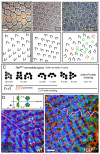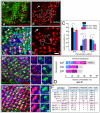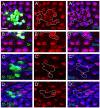Ral GTPase promotes asymmetric Notch activation in the Drosophila eye in response to Frizzled/PCP signaling by repressing ligand-independent receptor activation
- PMID: 21350007
- PMCID: PMC3114705
- DOI: 10.1242/dev.056002
Ral GTPase promotes asymmetric Notch activation in the Drosophila eye in response to Frizzled/PCP signaling by repressing ligand-independent receptor activation
Abstract
Ral is a small Ras-like GTPase that regulates membrane trafficking and signaling. Here, we show that in response to planar cell polarity (PCP) signals, Ral modulates asymmetric Notch signaling in the Drosophila eye. Specification of the initially equivalent R3/R4 photoreceptor precursor cells in each developing ommatidium occurs in response to a gradient of Frizzled (Fz) signaling. The cell with the most Fz signal (R3) activates the Notch receptor in the adjacent cell (R4) via the ligand Delta, resulting in R3/R4 cell determination and their asymmetric positions within the ommatidium. Two mechanisms have been proposed for ensuring that the cell with the most Fz activation sends the Delta signal: Fz-dependent transcriptional upregulation in R3 of genes that promote Delta signaling, and direct blockage of Notch receptor activation in R3 by localization of an activated Fz/Disheveled protein complex to the side of the plasma membrane adjacent to R4. Here, we discover a distinct mechanism for biasing the direction of Notch signaling that depends on Ral. Using genetic experiments in vivo, we show that, in direct response to Fz signaling, Ral transcription is upregulated in R3, and Ral represses ligand-independent activation of Notch in R3. Thus, prevention of ligand-independent Notch activation is not simply a constitutive process, but is a target for regulation by Ral during cell fate specification and pattern formation.
Figures










Similar articles
-
Frizzled/PCP-dependent asymmetric neuralized expression determines R3/R4 fates in the Drosophila eye.Dev Cell. 2006 Dec;11(6):887-94. doi: 10.1016/j.devcel.2006.09.016. Dev Cell. 2006. PMID: 17141162
-
Combinatorial signaling by the Frizzled/PCP and Egfr pathways during planar cell polarity establishment in the Drosophila eye.Dev Biol. 2008 Apr 1;316(1):110-23. doi: 10.1016/j.ydbio.2008.01.016. Epub 2008 Jan 26. Dev Biol. 2008. PMID: 18291359 Free PMC article.
-
Asymmetric Notch activation specifies photoreceptors R3 and R4 and planar polarity in the Drosophila eye.Nature. 1999 Feb 11;397(6719):523-6. doi: 10.1038/17389. Nature. 1999. PMID: 10028968
-
Wnt-Frizzled/planar cell polarity signaling: cellular orientation by facing the wind (Wnt).Annu Rev Cell Dev Biol. 2015;31:623-46. doi: 10.1146/annurev-cellbio-100814-125315. Annu Rev Cell Dev Biol. 2015. PMID: 26566118 Free PMC article. Review.
-
Frizzled/PCP signalling: a conserved mechanism regulating cell polarity and directed motility.Nat Rev Genet. 2007 Feb;8(2):126-38. doi: 10.1038/nrg2042. Nat Rev Genet. 2007. PMID: 17230199 Review.
Cited by
-
Competition in notch signaling with cis enriches cell fate decisions.PLoS One. 2014 Apr 29;9(4):e95744. doi: 10.1371/journal.pone.0095744. eCollection 2014. PLoS One. 2014. PMID: 24781918 Free PMC article.
-
Ral function in muscle is required for flight maintenance in Drosophila.Small GTPases. 2020 May;11(3):174-179. doi: 10.1080/21541248.2017.1367456. Epub 2017 Dec 28. Small GTPases. 2020. PMID: 29284321 Free PMC article.
-
Ligand-Independent Mechanisms of Notch Activity.Trends Cell Biol. 2015 Nov;25(11):697-707. doi: 10.1016/j.tcb.2015.07.010. Epub 2015 Oct 1. Trends Cell Biol. 2015. PMID: 26437585 Free PMC article. Review.
-
Ral inhibits ligand-independent Notch signaling in Drosophila.Small GTPases. 2012 Jul-Sep;3(3):186-91. doi: 10.4161/sgtp.19802. Epub 2012 Jul 1. Small GTPases. 2012. PMID: 22750761 Free PMC article.
-
Planar cell polarity controls directional Notch signaling in the Drosophila leg.Development. 2012 Jul;139(14):2584-93. doi: 10.1242/dev.077446. Development. 2012. PMID: 22736244 Free PMC article.
References
-
- Axelrod J. D. (2009). Progress and challenges in understanding planar cell polarity signaling. Semin. Cell Dev. Biol. 20, 964-971 - PubMed
-
- Balakireva M., Rosse C., Langevin J., Chien Y., Gho M., Gonzy-Treboul G., Voegeling-Lemaire S., Aresta S., Lepesant J.-A., Bellaiche Y., et al. (2006). The Ral/exocyst effector complex counters c-Jun N-terminal kinase-dependent apoptosis in Drosophila melanogaster. Mol. Cell. Biol. 26, 8953-8963 - PMC - PubMed
-
- Bray S. J. (2006). Notch signaling: a simple pathway becomes complex. Nat. Rev. Mol. Cell Biol. 7, 678-689 - PubMed
-
- Cagan R. L., Ready D. F. (1989). Notch is required for successive cell decisions in the developing Drosophila retina. Genes Dev. 3, 1099-1112 - PubMed
-
- Camonis J. H., White M. A. (2005). Ral GTPases: corrupting the exocyst in cancer cells. Trends Cell Biol. 15, 327-332 - PubMed
Publication types
MeSH terms
Substances
Grants and funding
LinkOut - more resources
Full Text Sources
Molecular Biology Databases

